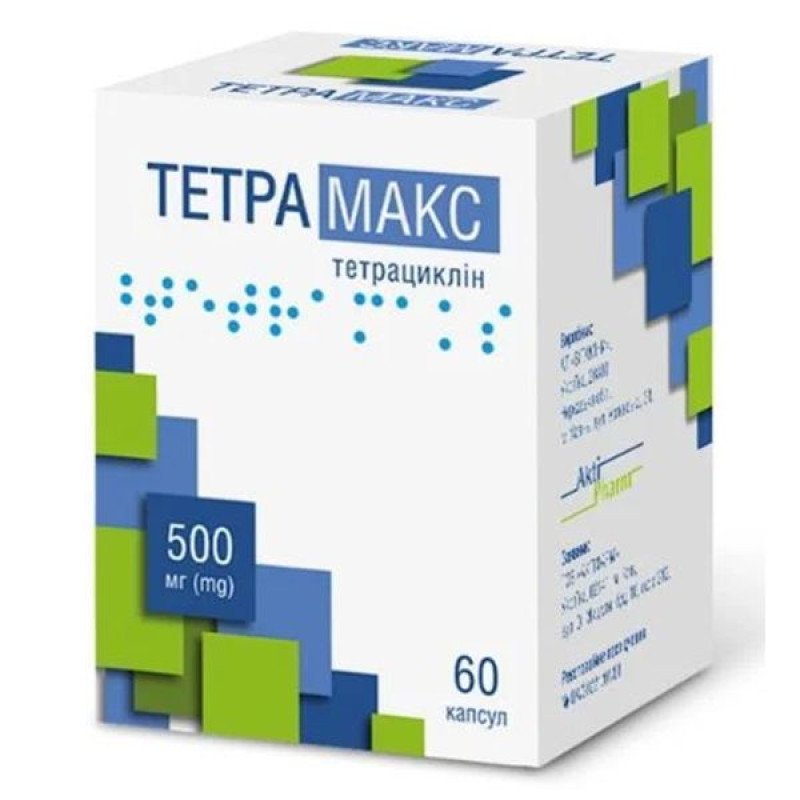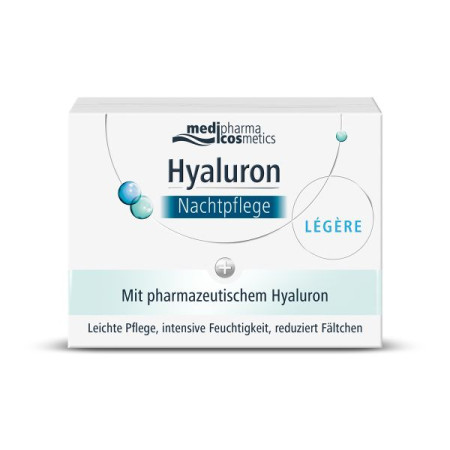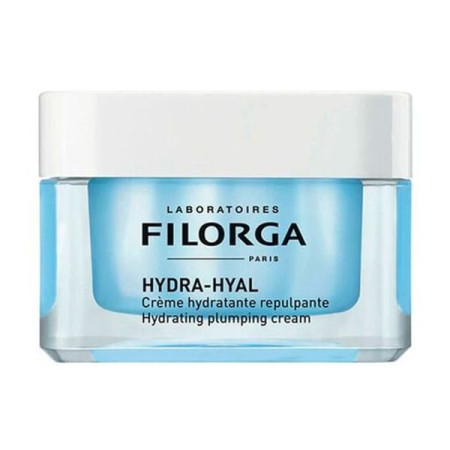TetraMax 500 mg capsules #60

Instructions TetraMax 500 mg capsules No. 60
Composition
active ingredient: tetracycline hydrochloride;
1 capsule contains tetracycline hydrochloride 500 mg calculated as 100% anhydrous substance;
excipients: lactose monohydrate, magnesium stearate; hard gelatin capsule: gelatin, azorubine (E122), indigo carmine (E132), titanium dioxide (E171), iron oxide yellow (E172), iron oxide red (E172).
Dosage form
Capsules.
Main physicochemical properties: hard gelatin capsules of cylindrical shape with hemispherical ends, body — pink, cap — burgundy. Capsule contents — powder from yellow to yellow-brown, the presence of agglomerate particles (a collection of particles that are firmly held together) is allowed.
Pharmacotherapeutic group
Antibacterials for systemic use. Tetracyclines. ATX code J01A A07.
Pharmacological properties
Pharmacodynamics.
Bacteriostatic antibiotic of the tetracycline group with a broad spectrum of action. Inhibits protein synthesis by blocking the binding of aminoacyl-transfer RNA (tRNA) to the messenger RNA (mRNA)-ribosome complex. Active against gram-positive (Staphylococcus spp., including those that produce penicillinase; Streptococcus spp., including Streptococcus pneumoniae; Haemophilus influenzae, Listeria spp., Bacillus anthracis) and gram-negative microorganisms (Neisseria gonorrhoeae, Bordetella pertussis, Escherichia coli, Enterobacter spp., Klebsiella spp., Salmonella spp., Shigella spp.), as well as Ricketsia spp., Chlamydia spp., Mycoplasma spp., Treponema spp., Borrelia spp., Vibrio cholera, Chlamydophila psittaci, Francisella tularensis, Campylobacter, Bartonella. Resistant to the drug: Pseudomonas aeruginosa, Proteus spp., Serratia spp., most strains of Bacteroides spp. and fungi, small viruses.
Pharmacokinetics.
1 hour after intravenous administration or rapid infusion of a single dose of 500 mg of tetracycline hydrochloride, its plasma concentration reaches 4–5 mg/l, while after repeated administrations at 12-hour intervals, some cumulation occurs, resulting in average plasma concentrations of tetracycline of 6.4 mg/l.
After oral administration of 500 mg of tetracycline hydrochloride, peak plasma concentrations are reached within 2 hours and average 3.0–4.3 mg/L after a single dose. After repeated oral administration of 500 mg to adults with normal liver function, steady-state plasma concentrations of tetracycline reach 1.5–4.3 mg/L. However, increasing the dose is not accompanied by a proportional increase in plasma concentrations.
The bioavailability of tetracycline when administered orally in adults on an empty stomach is 75–80%.
In adults with normal renal function, the plasma elimination half-life is 8–9 hours, but may be significantly prolonged in patients with renal insufficiency, depending on the degree of renal impairment. Plasma protein binding ranges from 36% to 64%.
Tetracycline hydrochloride is only slightly absorbed after intramuscular administration, resulting in lower plasma concentrations compared to oral administration.
Intestinal absorption can sometimes be significantly reduced by concomitant administration with certain foods or drugs. In particular, polyvalent cations such as iron, manganese, magnesium, and calcium can form non-absorbable chelate complexes with tetracycline.
Tetracycline is well distributed in tissues, especially the liver, gallbladder, kidneys, bones, teeth, genitals and mucous membranes of the sinuses. Effective concentrations are also achieved in various body fluids (pleural, pericardial, peritoneal and synovial fluids). On the other hand, it is present in cerebrospinal fluid only in small concentrations, constituting only 10–30% of its level in blood plasma, even in the presence of inflammation of the meninges.
Tetracycline accumulates in the liver. It is excreted with bile into the gastrointestinal tract, being partially reabsorbed (enterohepatic circulation).
Tetracycline is metabolized by approximately 30–50%, and 30–70% is excreted unchanged in the urine. It is dialyzable to a small extent, and peritoneal dialysis is ineffective.
Indication
The drug is used for infectious and inflammatory diseases caused by microorganisms sensitive to tetracycline hydrochloride, such as:
- Upper respiratory tract infections.
- Lower respiratory tract infections.
- Rickettsioses, including Rocky Mountain spotted fever, typhus group infections, and Q fever.
- Psittacosis.
- Trachoma
- Inguinal granuloma.
- Lyme disease with relapsing fever - as part of combination therapy.
- Bartonellosis.
- Tularemia.
- Cholera.
- Brucellosis.
- Campylobacteriosis - as part of combination therapy.
- Urinary tract infections.
- Other infections caused by susceptible Gram-negative organisms.
- Severe forms of acne - as part of a combination treatment.
When penicillin is contraindicated, tetracycline is an alternative drug for the treatment of the following infections:
- Syphilis.
- Gonorrhea
Contraindication
Hypersensitivity to tetracycline hydrochloride and related antibiotics, local anesthetics (lidocaine, procaine); fungal diseases, systemic lupus erythematosus. Pregnancy. Breastfeeding. Patient's age up to 12 years. Liver and kidney diseases with severe functional insufficiency.
There are known cases of benign intracranial hypertension with the simultaneous use of tetracyclines with vitamin A or retinoids, therefore their simultaneous use is contraindicated.
Interaction with other medicinal products and other types of interactions
Iron salts, oral preparations of zinc, calcium, bismuth (including bismuth subsalicylate), aluminum, magnesium and other preparations containing these cations (including magnesium-containing laxatives, antacids, sucralfate), cholestyramine, colestipol, kaolin-pectin, sodium bicarbonate: formation of inactive chelates with tetracycline and reduction of tetracycline absorption. Combination with such preparations should be avoided, as well as with quinapril (contains magnesium carbonate), didanosine (contains calcium and magnesium-containing excipients). If such a combination is necessary, the use of tetracycline should be as far apart as possible (2 hours before or 4–6 hours after their use).
Strontium ranelate: possible decrease in serum tetracycline concentrations. Concomitant use should be avoided. It is recommended to interrupt strontium ranelate treatment during tetracycline therapy.
Digoxin, lithium preparations: possible increase in their serum concentration.
Ergotamine and methysergide: increased risk of ergotism.
Penicillins, cephalosporins, beta-lactam antibiotics: as a bacteriostatic antibiotic, tetracycline may interfere with the bactericidal activity of other antibiotics. This combination should be avoided.
The combination of tetracycline with oleandomycin and erythromycin is considered synergistic.
Indirect anticoagulants, including warfarin, phenindione, antithrombotic agents: tetracyclines may enhance the effect of indirect anticoagulants due to inhibition of their metabolism in the liver, reduce the level of prothrombin in blood plasma, which requires careful monitoring of prothrombin time and, if necessary, a reduction in the dose of anticoagulants.
Atovaquone: decreased plasma concentrations of atovaquone.
Methoxyflurane: possible toxic effects on the kidneys (including increased levels of urea nitrogen and serum creatinine), acute renal failure, sometimes fatal.
Methotrexate: possible increase in the toxicity of the latter; such a combination should be used with caution. If concomitant use of the drugs is necessary, regular monitoring of toxicity is required.
Vitamin A and retinoids such as acitretin, isotretinoin, and tretinoin (for acne) may cause benign intracranial hypertension when used concomitantly with tetracyclines, and are therefore contraindicated. To prevent this complication, an interval should be observed after tetracycline therapy when treating acne with retinoids.
Hormonal contraceptives: reduced effectiveness (unplanned pregnancy) and increased frequency of breakthrough bleeding when used with tetracyclines. In this regard, it is recommended to use non-hormonal methods of contraception during treatment with tetracycline and for 7 days after the end of the course of treatment.
Diuretics: this combination requires caution, as dehydration increases the risk of nephrotoxicity.
Antidiabetic drugs (insulin, sulfonylurea derivatives, including glibenclamide, gliclazide): increased hypoglycemic effect.
Chymotrypsin increases the concentration and duration of tetracycline circulation in the blood.
Use caution when prescribing tetracycline with hepatotoxic drugs.
Oral typhoid vaccine, BCG: Antibacterial drugs, including tetracyclines, may reduce the therapeutic effect of these vaccines. Vaccines should be avoided during antibiotic treatment.
The absorption of tetracycline is impaired when taken with food, milk, and dairy products.
Application features
Esophagitis. Cases of esophagitis and esophageal ulcers have been reported in patients taking encapsulated or tableted forms of tetracyclines. The drug should be taken with plenty of liquid and swallowed in an upright position, sitting or standing, well before bedtime. If symptoms such as dysphagia or chest pain occur, the possibility of this complication should be considered and the drug should be discontinued. Tetracycline should be used with caution in patients with esophageal reflux.
Due to the possible development of photodermatoses (increased photosensitivity when using tetracycline antibiotics), the drug should not be used in sunlight or under the influence of UV radiation.
Microflora. The use of antibiotics may lead to overgrowth of non-susceptible microorganisms, in particular fungi, including Candida, and to the development of superinfection, which requires discontinuation of the antibiotic and taking appropriate measures.
To prevent the development of candidiasis, it is recommended to use antifungal drugs and vitamins simultaneously with tetracycline.
Diarrhea, especially severe, persistent, and/or bloody, during or after treatment (including several weeks after treatment) with tetracyclines may be a symptom of Clostridium difficile-associated diarrhea (CDAD). The severity of CDAD can range from mild diarrhea to life-threatening pseudomembranous colitis.
The possibility of CDAD should be considered in all patients who develop severe diarrhea during or after antibiotic use.
Tooth development. The use of tetracyclines during the period of tooth development (II-III trimesters of pregnancy, breastfeeding, neonatal period, children up to 12 years of age) may cause irreversible discoloration of the teeth (yellow-brown-gray). This adverse reaction occurs more often with long-term use, but can also occur after repeated short courses of treatment. There have also been reports of enamel hypoplasia.
Venereal diseases. Tetracyclines may mask the manifestations of syphilis. Appropriate diagnostic procedures should be used when treating venereal diseases with suspected concomitant syphilis. In all such cases, monthly serological tests should be performed for at least 4 months.
Beta-hemolytic streptococcus: For infections caused by group A beta-hemolytic streptococci, treatment should be continued for at least 10 days.
Myasthenia gravis. The drug should be used with caution in patients with myasthenia gravis due to the possibility of mild neuromuscular blockade.
Systemic lupus erythematosus, porphyria. Tetracyclines may cause exacerbation of systemic lupus erythematosus. Rare cases of porphyria have been reported in patients receiving tetracyclines. Therefore, tetracycline should not be used in patients with porphyria or systemic lupus erythematosus.
Renal impairment. Tetracycline use is generally contraindicated in renal failure due to the possibility of excessive accumulation and increased risk of side effects.
The anti-anabolic effects of tetracyclines may cause an increase in blood urea nitrogen. Although this is not significant in patients with normal renal function, in patients with significantly impaired renal function, high serum levels of tetracycline may lead to azotemia, hyperphosphatemia, and acidosis.
Hepatic impairment. Tetracycline should be used with caution in patients with impaired hepatic function and in patients receiving potentially hepatotoxic drugs. High doses of the drug should be avoided. High doses of tetracycline have been associated with the development of fatty liver and pancreatitis.
Tetracycline hydrochloride should be prescribed with caution in cases of leukopenia.
Since tetracyclines reduce plasma prothrombin activity, patients on anticoagulant therapy may require a reduction in the dose of anticoagulants.
With prolonged use of the drug, blood tests, kidney and liver function tests should be performed periodically.
Tetracycline therapy should be carried out under the supervision of a physician. The prescribed regimen should be strictly followed throughout the course of treatment, doses should not be missed and should be taken at regular intervals. If a dose is missed, take it as soon as possible; do not take it if it is almost time for the next dose; do not double the dose. Tetracycline hydrochloride should not be taken simultaneously with milk or other dairy products, as this impairs its absorption.
In case of signs of hypersensitivity to the drug and adverse reactions, discontinue use of the drug, and if necessary, prescribe another antibiotic (not from the tetracycline group). To prevent possible complications, it is advisable to simultaneously use hepatoprotectors, choleretics, eubiotics, vitamins, and antifungal drugs.
Tetracycline is not the drug of choice in the treatment of any type of staphylococcal infection.
It is inappropriate to prescribe the drug to adults in doses less than 800 mg per day, since in addition to insufficient therapeutic effect, the development of tetracycline-resistant forms of microorganisms is possible.
The medicine contains lactose, so if the patient has been diagnosed with an intolerance to some sugars, you should consult a doctor before taking it.
The medicine contains the dye azorubine (E122), which may cause allergic reactions.
Use during pregnancy or breastfeeding
Tetracyclines cross the placenta and can have a toxic effect on fetal tissues, especially on skeletal development, so the drug is contraindicated during pregnancy.
All tetracyclines form stable calcium complexes in any bone-forming tissue (skeletal, enamel, dentin of teeth). A decrease in the growth rate of the tibia has been observed in premature infants who received oral tetracycline at doses of 25 mg/kg every 6 hours. This adverse reaction was reversible upon discontinuation of the drug.
When tetracyclines are used during tooth development, they can be deposited in the tissues of the teeth, causing permanent discoloration (see section "Special instructions for use").
Ability to influence reaction speed when driving vehicles or other mechanisms
There is no data on the negative impact of the drug on the ability to drive and operate machinery.
Method of administration and doses
Tetracycline should be taken 1 hour before or 2 hours after a meal, as food, including some dairy products, interferes with absorption. The tablets should be taken with water.
The dosage and course of treatment are determined by the doctor individually depending on the nature and course of the disease.
Treatment should be continued for another three days after the disappearance of clinical manifestations of the disease.
All infections caused by β-hemolytic streptococcus should be treated for at least 10 days.
Adults and children over 12 years of age: The usual dose is 500 mg twice a day. In severe infections, the dose may be increased to 500 mg 4 times a day.
The maximum daily dose is 2 g.
For the treatment of brucellosis: 500 mg of tetracycline four times a day for three weeks, accompanied by streptomycin 1 gram intramuscularly twice a day for the first week and once a day for the second week.
For the treatment of syphilis: The following doses of tetracycline are recommended for patients with a penicillin allergy:
early syphilis (duration less than one year) - 500 mg four times a day for 15 days;
syphilis lasting more than one year (except neurosyphilis) - 500 mg four times a day for 30 days.
For the treatment of moderate to severe acne: the recommended initial dose is 1 gram per day, divided into 2 doses. If improvement occurs, the dose should be gradually reduced to maintenance levels (125 mg to 500 mg per day). In some patients, adequate remission of lesions may be maintained with alternate daily or intermittent therapy. Tetracycline therapy for acne does not replace other standard measures for the prevention and treatment of acne. A safe duration of treatment that can be recommended has not been established (see sections “Special instructions” and “Adverse reactions”).
Elderly patients: Use the usual adult dose. Use with caution in subclinical renal failure as this may lead to drug accumulation.
Renal insufficiency. Tetracyclines are generally contraindicated in renal insufficiency unless the use of this class of drugs is considered absolutely necessary. The daily dose should be reduced by reducing the recommended individual doses and/or by increasing the intervals between doses.
To reduce the risk of esophageal irritation and ulceration, it is recommended that sufficient fluid be administered with the capsule form of tetracycline (see section "Adverse Reactions").
Children: Do not use the medicine in children under 12 years of age.
Overdose
Symptoms: nausea, vomiting; when using doses significantly exceeding the recommended ones - crystalluria, hematuria. It is possible to increase the manifestations of the described side effects, including hypersensitivity reactions.
Treatment: symptomatic therapy. There is no specific antidote. Tetracycline is not dialyzable.
Side effects
Immune system: hypersensitivity reactions, including urticaria, angioedema, including face and tongue, anaphylaxis, pericarditis, bronchospasm; anaphylactoid reactions, including anaphylactoid purpura, exacerbation of systemic lupus erythematosus, fixed drug erythema, exfoliative dermatitis, Stevens-Johnson syndrome, toxic epidermal necrolysis.
Skin and subcutaneous tissue: itching, skin hyperemia, rashes, including maculopapular, erythematous, photosensitivity reactions, bullous dermatoses, pigmentation disorders of the skin and mucous membranes.
Blood and lymphatic system: hemolytic anemia, thrombocytopenia, neutropenia, eosinophilia, agranulocytosis, aplastic anemia, Moszkowitz's disease.
Endocrine system: with prolonged use of tetracyclines, microscopic brown-black areas may appear in the thyroid tissue. Thyroid function is not impaired.
Digestive system: anorexia, nausea, vomiting, dry mouth, abdominal discomfort/pain, dyspepsia (including heartburn/gastritis), dysphagia, diarrhea/constipation, intestinal dysbacteriosis, pancreatitis. Cases of esophagitis and esophageal, gastric, and duodenal ulcers have been reported in patients taking tetracycline capsules and tablets.
Hepatobiliary system: hepatotoxicity with transient increase in hepatic transaminases, alkaline phosphatase and bilirubin in the blood, liver dysfunction; hepatitis, jaundice, fatty liver, liver failure. The first symptoms of liver damage may be malaise, fever and/or pain in the right hypochondrium, stomach pain, nausea, vomiting, subicteric sclera.
Effects due to biological action: with prolonged use of high doses of antibiotics, including tetracycline, the development of superinfection is possible, which can cause the development of candidiasis, glossitis with papillary hypertrophy, glossopharyngitis, stomatitis, staphylococcal enterocolitis, CDAD, pseudomembranous colitis, itching in the anal area, inflammatory lesions of the anogenital area (due to candidiasis), vulvovaginitis, balanitis, proctitis.
Musculoskeletal system: increased muscle weakness in patients with myasthenia gravis.
Urinary system: azotemia, hypercreatininemia, nephritis, acute renal failure, usually in patients with pre-existing renal dysfunction.
Other: sore throat, hoarse voice, pharyngitis, hypovitaminosis, irreversible tooth discoloration (yellow-brown-gray), tooth enamel hypoplasia in children, impaired bone formation, slowing of linear bone growth (in children).
Expiration date
3 years. Do not use after the expiry date stated on the packaging.
Storage conditions
Store in the original packaging at a temperature not exceeding 25°C.
Keep out of reach of children.
Packaging
10 capsules in a blister; 3 or 6 blisters in a pack.
Vacation category
According to the recipe.
Producer
JSC "VITAMINS".
Location of the manufacturer and address of its place of business.
Ukraine, 20300, Cherkasy region, Uman city, Uspenska st., 31.
Applicant.
LLC "ACTIPHARM".
Location of the applicant.
Ukraine, 02141, Kyiv, O. Myshugy St., building 10, office 212.
There are no reviews for this product.
There are no reviews for this product, be the first to leave your review.
No questions about this product, be the first and ask your question.





